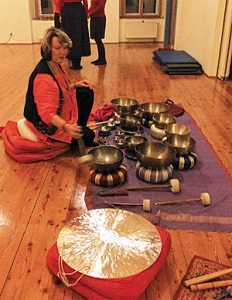 by guest author Dr. Rosa Matzenberger
by guest author Dr. Rosa Matzenberger
As a clinical psychologist and psychotherapist, I have successfully integrated Peter Hess® Sound Methods into my work for many years and combine them with various other psychotherapeutic approaches. One steadily increasing area of work into which sound therapies can be easily implemented is the treatment of patients suffering from burnout. While burnout used to be classified as a typical “manager disease” or associated with “caregiver professions”, we can now call it a real epidemic. For example, in May 2017, the STANDARD reported the following on a study focusing on workplace illnesses: “One third consider themselves to be at least at mild risk of burnout in their respective jobs.“ “According to the WHO, depression and burnout will account for 50% of all diseases by the year 2050“, says psychiatrist Dr. Reinhard Haller. The increasing number of those affected by burnout is also reflected in the Health Atlas 2015 of German corporate health insurers. Statistics of the Atlas show that approx. 15 % of worker absences were due to psychological pressures, which include burnout. Worker absences for psychological problems where twice as long as those for illnesses of the musculoskeletal system. This causes significant socioeconomic damage. It is therefore not surprising that improving health – both physical and mental – is increasing in importance in our healthcare system and will lead to a paradigm shift. The focus is increasingly directed toward factors that promote and maintain health rather than those that cause disease. It is here that the Peter Hess® Sound Methods with their holistic solution and resource-oriented approach can provide valuable services.
Burnout a condition of chronic fatigue
When do we consider someone to be suffering from burnout?
Burnout syndrome (or simply burnout) is a condition of extreme emotional and physical fatigue with reduced performance capacity. The condition generally begins quietly, unnoticed by those affected. It develops primarily across three stages: in the beginning, there is emotional fatigue that leads to neglect of one’s own wishes and needs. In the second phase, depersonalization, cynicism, and rejection of others arise. This leads to self-doubt with regard to one’s own capabilities and social withdrawal. In the third stage, nothing at all works – complete collapse, an infarct of the soul. Somatically, burnout is associated with a broad range of unspecified symptoms.
Being “burnt out” is often the result of persistent distress that may also lead to headaches, abdominal symptoms or back pain, tinnitus, hearing loss, dizziness, nervousness, irritability, and feelings of frustration as well as heart arrhythmias, chronic sleeping disorders, or memory problems. Feelings of helplessness, often coupled with feelings of uselessness and being overwhelmed, follow. People suffering from burnout feel as though they know longer know who they are. A feeling of inner emptiness evolves and results in depression. Personal resources are depleted, exhausted. Those who give a lot also need to take in, refill, and recharge. If this does not happen, burnout may lead to complete inability to work or even suicide. Detailed evaluation is therefore always important if there is suspicion of burnout.
It is therefore essential: take counter measures as quickly as possible and embrace preventative actions!
What are the causes?
The causes of burnout are multifactored. Chronic stress due to social, professional, or family issues as well as personal dispositions impact burnout. It is difficult to maintain inner balance given the general high level of stress all around us. Deadlines, multiple stresses, competition, and work responsibilities are continually increasing. The pressure to accomplish things faster, better, while keeping pace with permanent changes – professionally as well as personally – is a feeling that most of us know. Scientists define this phenomenon as “social acceleration.” The pressure to be online all the time and high expectations of perfectionism do the rest. There is a term that describes the pathological fear of missing something in the digital world “fear of missing out” or “fomo”.
”People do not suffer from events, but from their assessment of events.“ (Epiktet, Greek philosopher)
Burnout Prevention and Burnout Treatment
Based on its many causes, burnout should always be viewed and understood in a bio-psycho-social context. Therefore, prevention and treatment should be implemented at various levels. A heathy lifestyle, work-life balance, and fulfilling social relationships – these are the central ingredients to preventing burnout syndrome.
Furthermore, according to the Salutogenesis model by Aaron Antonovsky, there is an important protective factor in resilience, “psychological resilience” against environmental stressors. Loving relationships are what constitutes the central resiliency factor, since good social relationships reduce stress! Antonovsky’s model highlights the importance of a sense of belonging and deep inner satisfaction with oneself and others (cf. also Krause, 2016).
Important starting points in burnout prevention and treatment are therefore awareness of self-worth and personal limits: new outlook, relaxation, self- awareness, self-regulation, and self-appreciation. Consequently, new solution strategies are created for dealing with stress, resources, alternative life-work balance, ability to handle conflict, and psychotherapeutic processing of psychological pressures. They form the foundation of self-empowerment. The strengthening of one’s own resilience, the transformation of negative belief systems, whereby “inner beliefs” are reworked in such a way that the affected individual once again takes charge of his or her life instead of trying to catch up with a full appointment schedule or allowing one’s course to be determined by “internal drivers.” Ultimately, it is about being the creator of your own life again, to treat yourself with love and respect and taking the time for togetherness.
To achieve this healthy balance between tension and relaxation and thereby a good work-life balance, working with Peter Hess® Sound Methods presents an outstanding resource that develops into resilience.
Sound methods for treatment of burnout
 The term Peter Hess® Sound Methods encompasses sound massage as well as all associated specific implementation possibilities of singing bowls and gongs. This also includes, for example, sound-supported fantasy journeys, sound trips, so-called “sound baths” as well as sound exercises that can be done independently at home. Depending on level of burnout, patients respond better and more quickly to various sound therapy approaches. The sounds can effectively support various aspects of treatment and, in my experience, regular application is a very effective means of breaking through the burnout spiral (cf. Matzenberger, 2009).
The term Peter Hess® Sound Methods encompasses sound massage as well as all associated specific implementation possibilities of singing bowls and gongs. This also includes, for example, sound-supported fantasy journeys, sound trips, so-called “sound baths” as well as sound exercises that can be done independently at home. Depending on level of burnout, patients respond better and more quickly to various sound therapy approaches. The sounds can effectively support various aspects of treatment and, in my experience, regular application is a very effective means of breaking through the burnout spiral (cf. Matzenberger, 2009).
Sound therapy is a very important tool for me because it:
- Radiates a high level of attractiveness and is easily accepted – patients don’t have to actively do anything – they can simply enjoy, simply be
- Presents a low threshold opportunity to recharge, and a starting point to reduce stress
- Promotes deep relaxation and accompanying regeneration and, in the sound room, often positive feelings of trust, assurance, comfort – key word: primal trust
- Strengthens relaxation and associated positive feelings and thereby helps break down burnout-relevant negative feelings such as frustration, anger, or anxiety
- Develops learning how to relax as an important base for successful stress management
- Teaches individuals suffering from burnout how to become aware of their bodies and thereby also their desires and needs in the sense of “what is good for me?”
- Fosters self-trust and self-confidence and thereby leads to self-empowerment
- Together with sound exercises you can do at home, provides opportunity to something good for yourself and think about yourself
- Supports the building of the patient-therapist relationship and helps patients restart their ability to make social contact
Inspirations for burnout prevention and treatment with sound therapy
“If we refuse to go on the journey, it could be that we never get to play the music of our life. We may never sing our primal song. Would that not be tragic? Because the world needs your song; it remains incomplete without it and waits with endless patience on the moment you begin your song.”
(Santorelli 2009, quoted in Baatz, 2012)
First encounter with sound
Here, the motto: less is more! is especially true. Completely exhausted or depressed individuals often cannot physically tolerate sound. I therefore always start very, very slowly with a few sounds away from the body. Because once relaxation sets in, exhaustion can also become more pronounced and lead to a longer phase of sleepiness or tiredness. It is important to determine the framework of a session in advance so that clients allow sufficient time for the regeneration process afterwards.
Opportunity for relaxation and wellbeing
For most of my clients, the first step away from burnout, the chronic activation of the sympathetic nervous system, is the initiation of parasympathetic regulation, i.e., relaxation and rejuvenation. Just the situation that a sound massage or sound journey invites, to simply be without having to do anything, promotes letting go. Enjoying vibrations and harmonious sounds and drifting into a deep state of relaxation is very restorative and rejuvenating. When clients are suffering from extreme exhaustion, they often fall asleep during sound therapy. Following this short period of deep sleep, they awake refreshed, relaxed and regenerated. Most certainly, the needs of the body are felt again. The perception of all senses is sharpened, and life is experienced more consciously. In many cases, patients reported that after a sound therapy session, it was the first time in a long while that they fell and remained asleep without problems. This enables deep regeneration. Some clients are very surprised: ”It’s been a long time since I’ve felt as relaxed and rejuvenated as I have during this sound journey – and I slept so well afterwards,” said a long-time sufferer of chronic sleep disorders.
The experience of being in harmony
What is important to me is to show my clients what it feels like to find their own center. With sound, the inner realm is quickly explored, and internal sources of strengths rediscovered. This type of resource work is so effective, that patients can more easily abandon their destructive behavior. Often, they then ask themselves why they had waited so long to do this. The fulfilment of our most elemental, most primal need – to be in harmony with ourselves – that is the goal. A new body sensation, a new body experience is created. Creativity and activity are reawakened.
To “flow” once again
The term “flow“ is a word that is repeatedly mentioned by patients within the context of sound therapy. With “flow“ we refer to, among other things, the full immersion into an activity, into being, into being one with yourself and the world in a natural, exciting, and joyful way. To dive into the flow of our life and get life energy to flow is the motto. Through sound massage, the clients once again feel connected to their source of strength, happiness, and confidence, and appear happy and radiating. ”Everything is still swinging“, is what a lot of patients say and what they mean is that swinging is synonymous with life, being alive, and “flowing.”
Variety of combination opportunities with sound therapy
 Another plus for me is the great variety of combination opportunities for sound therapies with other psychotherapeutic methods. I would like to elaborate on these and provide examples in the following.
Another plus for me is the great variety of combination opportunities for sound therapies with other psychotherapeutic methods. I would like to elaborate on these and provide examples in the following.
Sound-supported hypnotherapeutic trance journeys – health image
I use singing bowls and gongs in a specific way to intensify the effect of hypnotherapeutic trance journeys, which have an overall deep relaxation effect. Metaphors, images, and stories that address the problem and indirectly provide solutions can be presented to the patient. In this manner, the unconscious is awakened, and resources can be activated. Journeys though the body (body scan) and to the desired health image with all variations of change are especially effective (cf. Matzenberger, 2007). In many respects, the idea of a healthy body is a significant step that activates the powers of self-healing, as evidenced in research studies. In my own psychotherapeutic practice, I like to use the imagery of the patient’s own concept of health (cf. Koller/Grotz, 2010).
Mastering the autosuggestion
A significant component of burnout therapy is the application of autosuggestion in the form of learning how to relax. As opposed to autogenic training, there is no repetition of formulated sentences here. Instead, there is focused attention on the perception of the sounds in the here and now, in the body, and in the environment. This can be easily practiced at home. Patients learn to concentrate on their breathing, perception of their bodies, changes from external to internal stimuli and learn how to thereby relax. The auditory and sensory experiences during a sound massage or during sound exercises at home often lead patients into a regenerating state of relaxation and changed level of consciousness beginning with the first sound impulse (cf. Ross, 2009).
Sound relaxation for pain
As already mentioned, burnout is often associated with depression, psychosomatic symptoms, and chronic pain. The further the progression of the exhaustion spiral, the less the body is able to overcome pain. This often leads to chronic sensation of pain in those affected by burnout. An intensification loop develops that consists of pain, tension, discomfort, and pain-related stress. Pain increases, anchors in the pain memory and can then be triggered by only a mild irritant. Breaking through this pain spiral cycle is goal number one.
The sounds, with their relaxing effects, have proven to be an effective tool in treating these symptoms. Following sound therapy, patient report enormous changes in terms of wellbeing, reduction in pain, and sometimes even complete remission of pain (cf. Matzenberger, 2007).
Sample case: A patient who had suffered a prolonged burnout phase and had undergone breast cancer surgery sought treatment from me. Following three interventions in rapid succession, she complained of severe pain and extensive impairments. During the sound massage, I could already tell from her facial expression, which showed a relaxed smile, and her deep abdominal breathing, the positive effects sound therapy was having on her. Afterwards, she explained to me that during the sound massage, for the first time in a long while, she experienced her body the way she wanted to experience it. “Finally, since a very long time, I am without this pain. How wonderful it is to feel my body in this state – free, light, healthy, and completely free of pain. I can feel that everything is ok, and I believe that I will be totally healthy again.“ She was completely happy and grateful. Even her lymphatic congestion and ache in her arm were reduced in a pleasant flow. To her, experiencing her body in its healthy potential after all her painful experiences was the greatest gift. It gave her renewed hope, trust, and confidence in the healing power of her body.
Attentiveness training
The concept of attentiveness helps in perception of the body and its needs, and in incorporating the body as a source of knowledge and wellbeing: attentiveness training lends itself to combination with sound therapy, for example during a body scan and various other guided meditations. During these exercises, patients learn to pause, to step away from burnout-promoting thoughts and behavior patterns, to remain calm, and to decelerate and concentrate on what is important. According to Thich Nhat Hahn “new habits should be cultivated like small plants“. Short, daily sound exercises, incorporated as an everyday ritual, make this possible in an easy and pleasant way.
Breathing
Conscious, relaxed breathing is another method recommended to destress and is facilitated through sound therapy. During a sound massage, breathing patterns are naturally and instinctively affected. Stimulated by the soothing vibrations of the sounds, and generally unintentionally, deep abdominal breathing ensues. With the help of verbal or nonverbal induction, attentiveness to breathing and deeper breathing can be consciously guided. Blocked areas of the body can be made conscious through breathing and released.
The sounds also strengthen me as therapist
Integration of the multifaceted Peter Hess® Sound Methods into my psychotherapeutic practice is a great enrichment for me. The sounds not only resonate strongly with my patients, but also with me, strengthening my health and resilience. So, I am also doing something good for myself.
 Dr. phil. Rosa Matzenberger is a clinical and health psychologist, a psychotherapist in family therapy, and an infant, pediatric, and youth psychotherapist. She is also a supervisor and instructor in hypnotherapy according to M. E. Erickson, systemic structuring, trauma and ego-state therapy. She is an accredited Peter Hess® Sound Massage practitioner and docent at Peter Hess® Institute since 2002. She has been working in the clinical arena with children, teens, adults, and families for more than 25 years. She is an independent practitioner, presenter at seminars, and instructor. Since 2002, she applies Peter Hess® Sound Methods to many specialty areas of her professional field.
Dr. phil. Rosa Matzenberger is a clinical and health psychologist, a psychotherapist in family therapy, and an infant, pediatric, and youth psychotherapist. She is also a supervisor and instructor in hypnotherapy according to M. E. Erickson, systemic structuring, trauma and ego-state therapy. She is an accredited Peter Hess® Sound Massage practitioner and docent at Peter Hess® Institute since 2002. She has been working in the clinical arena with children, teens, adults, and families for more than 25 years. She is an independent practitioner, presenter at seminars, and instructor. Since 2002, she applies Peter Hess® Sound Methods to many specialty areas of her professional field.
If you are interested in more english articles, read on…